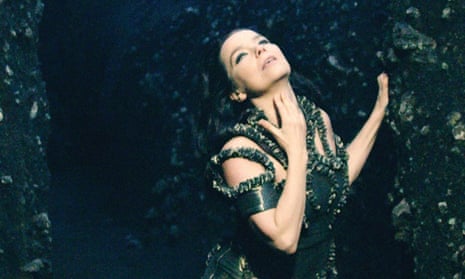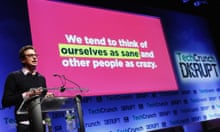Music videos that make a virtue of innovation tend to hammer the point home with bells and whistles, spaceships and explosions: for example, Michael and Janet Jackson’s Scream, Kanye’s Power or more recently, Azealia Banks’ mirror-game for Wallace or Arcade Fire’s interactive We Used to Wait.
The Guardian’s product and service reviews are independent and are in no way influenced by any advertiser or commercial initiative. We will earn a commission from the retailer if you buy something through an affiliate link. Learn more.
However, the premiere of Björk’s immersive virtual reality video for Stonemilker reduced people to tears featuring just a woman on a beach. The video, directed by Andrew Thomas Huang was shown, using a headset that turned a smartphone into a VR device, to fans who had purchased a copy of her new album, Vulnicura, from Rough Trade East in London. It can also be seen at Rough Trade New York until 28 March and as part of MoMa’s Björk exhibition, which runs until 7 June.
Björk is justly hailed as a pioneer in the art of the music video, and the clips from Vulnicura so far have been typically impressive: the ornate, costumed Inez & Vinoodh video for Lionsong and the CGI-heavy collaboration with Huang for Family, along with the heartbreaking cavern-of-despair trailer for Black Lake, which can be seen in full only at MoMA.
Stonemilker, though, is different. Shocking, not with flash and craft, but with its intimacy and simplicity; it uses its tech not to dazzle, but to enable the song to do its heart-shredding work better. The track opens the album, detailing the first realisations that Björk’s relationship with artist Matthew Barney was breaking down. It was written in the same place that the video was filmed, Grotta’s beach on the edge of Reykjavík, a fact that only serves to underline its emotional power.
As in Björk’s videos for Joga or Triumph of a Heart, the dramatic Icelandic landscape plays its own role. As you pull the headset over your eyes, you find yourself transported to that black sand beach, the hiss of the waves mixing with the rising strings, the chatter of Sunday record shoppers silenced. Björk, in the same yellow dress she wears at the end of the Family video, stands in front of you, singing: “All that matters is who is open-chested and who has coagulated.” She sings directly to you, gesturing to the sky and sea with graceful twirling hand gestures. She then, quite calmly, splits in two, and you can turn back and forth between the two Björks, as if listening to their different points of view. The sound of the music is all around you, deeply felt.
Very deeply felt, in fact. Dave Black, head of marketing at Rewind, who with fellow UK company Third Space Agency, were responsible for turning the virtual reality world created from Huang’s 360-degree camera footage by LA company VRSE Works and VFX specialists Digital Domain into the app I’ve witnessed, tell me there have been a couple of people crying already today, and I have to admit to a bit of a tingling feeling around the eyeballs myself: it is an intense experience.
After a few minutes, the view darkens, and we are on a different part of the beach, rockier, with sheets of black rock extending out to sea and a lighthouse in the distance. Björk continues to twist and twine her hands, confiding and imploring, stepping around you, dividing now into three. And then, sadly, it comes to an end.
It’s the second virtual reality experience I’ve had this year, the first being an Oculus Rift recreation of the Wall at the Game of Thrones exhibition at London’s O2. Where that turned legs to jelly with its sudden, vertiginous plunge into icy doom, Stonemilker has the same effect on your heart, in a much more subtle way.
The power is not just in the visuals – though those prove so enticing that I want to head off down the black beach to explore before I remember there’s a wall a few centimetres in front of my face, back in Rough Trade’s small side-room. It’s also in the sound, which feels totally natural, encompassing and embracing you, and is made possible by Edinburgh company Two Big Ears’ 3DCeption audio technology.
Björk stressed that she was interested in the 360-degree camera mainly for its “potential for intimacy”, saying “that location has a beautiful 360 panoramic view which matches the cyclical fugue like movement in the song. If the song has a shape it is sort of like a circle that just goes on forever.” The sound, too, was remixed into a circular form, stripped down to match the beach environment by Björk, her engineer Chris Elms, and binaural sound expert Chris Pike.
“I had recorded the strings with a clip-on mic on each instrument. We have made a different mix where we have fanned this in an intimate circle around the listener. So, as you watch this in the virtual reality headset, it will be as if you are on that beach with the 30 players sitting in a circle tightly around you.”
The Freefly headset sells for as little as £67, so if more artists follow Björk’s lead, perhaps this sort of intimate, intense, experience could become commonplace – the music video as something truly immersive, an all-encompassing, focusing experience, rather than one distracted tab on your laptop screen. Now that really would be a technological achievement.
- This piece was amended on 26 March to clarify that Björk’s engineer is Chris Elms, while her binaural sound expert for this project was Chris Pike.




Comments (…)
Sign in or create your Guardian account to join the discussion